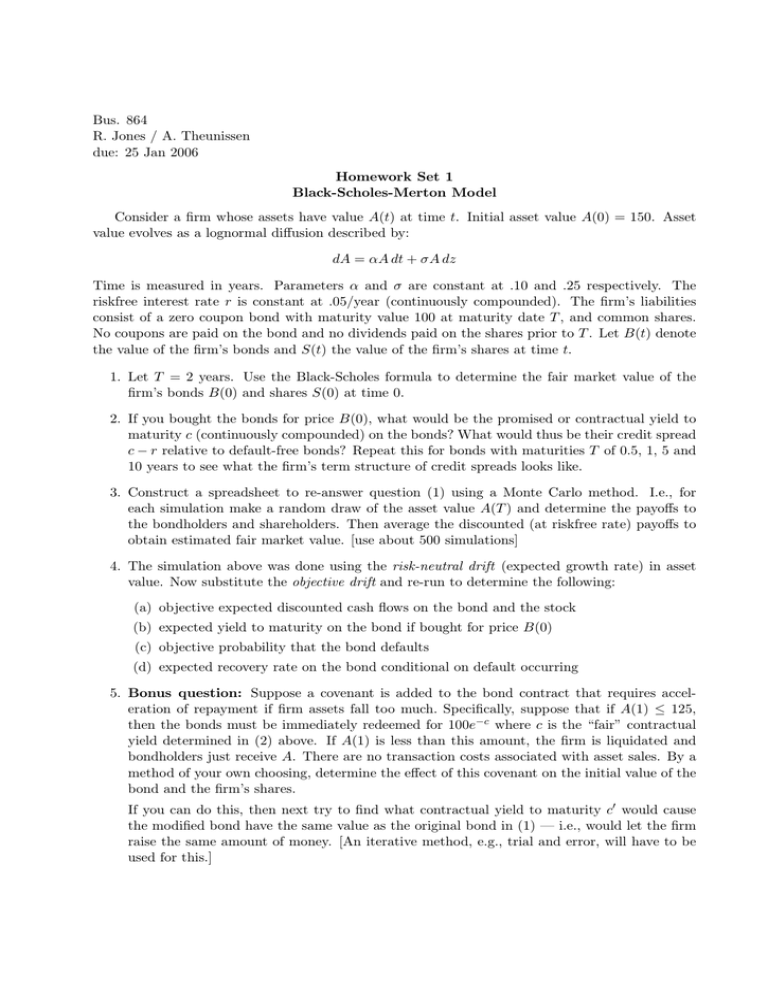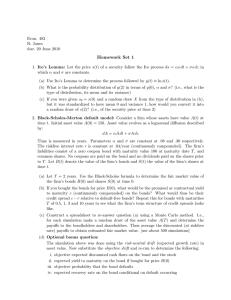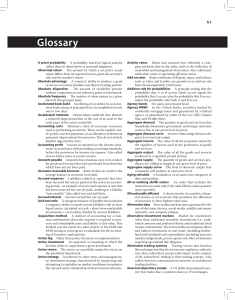Bus. 864 R. Jones / A. Theunissen due: 25 Jan 2006
advertisement

Bus. 864 R. Jones / A. Theunissen due: 25 Jan 2006 Homework Set 1 Black-Scholes-Merton Model Consider a firm whose assets have value A(t) at time t. Initial asset value A(0) = 150. Asset value evolves as a lognormal diffusion described by: dA = αA dt + σA dz Time is measured in years. Parameters α and σ are constant at .10 and .25 respectively. The riskfree interest rate r is constant at .05/year (continuously compounded). The firm’s liabilities consist of a zero coupon bond with maturity value 100 at maturity date T , and common shares. No coupons are paid on the bond and no dividends paid on the shares prior to T . Let B(t) denote the value of the firm’s bonds and S(t) the value of the firm’s shares at time t. 1. Let T = 2 years. Use the Black-Scholes formula to determine the fair market value of the firm’s bonds B(0) and shares S(0) at time 0. 2. If you bought the bonds for price B(0), what would be the promised or contractual yield to maturity c (continuously compounded) on the bonds? What would thus be their credit spread c − r relative to default-free bonds? Repeat this for bonds with maturities T of 0.5, 1, 5 and 10 years to see what the firm’s term structure of credit spreads looks like. 3. Construct a spreadsheet to re-answer question (1) using a Monte Carlo method. I.e., for each simulation make a random draw of the asset value A(T ) and determine the payoffs to the bondholders and shareholders. Then average the discounted (at riskfree rate) payoffs to obtain estimated fair market value. [use about 500 simulations] 4. The simulation above was done using the risk-neutral drift (expected growth rate) in asset value. Now substitute the objective drift and re-run to determine the following: (a) objective expected discounted cash flows on the bond and the stock (b) expected yield to maturity on the bond if bought for price B(0) (c) objective probability that the bond defaults (d) expected recovery rate on the bond conditional on default occurring 5. Bonus question: Suppose a covenant is added to the bond contract that requires acceleration of repayment if firm assets fall too much. Specifically, suppose that if A(1) ≤ 125, then the bonds must be immediately redeemed for 100e−c where c is the “fair” contractual yield determined in (2) above. If A(1) is less than this amount, the firm is liquidated and bondholders just receive A. There are no transaction costs associated with asset sales. By a method of your own choosing, determine the effect of this covenant on the initial value of the bond and the firm’s shares. If you can do this, then next try to find what contractual yield to maturity c0 would cause the modified bond have the same value as the original bond in (1) — i.e., would let the firm raise the same amount of money. [An iterative method, e.g., trial and error, will have to be used for this.]








